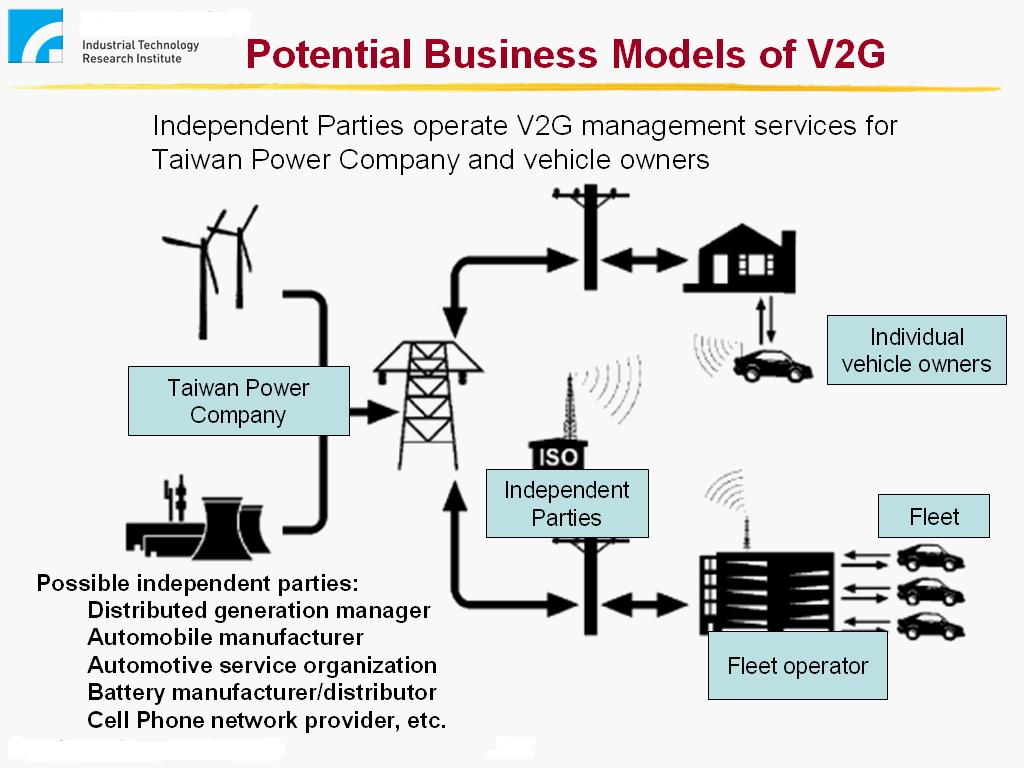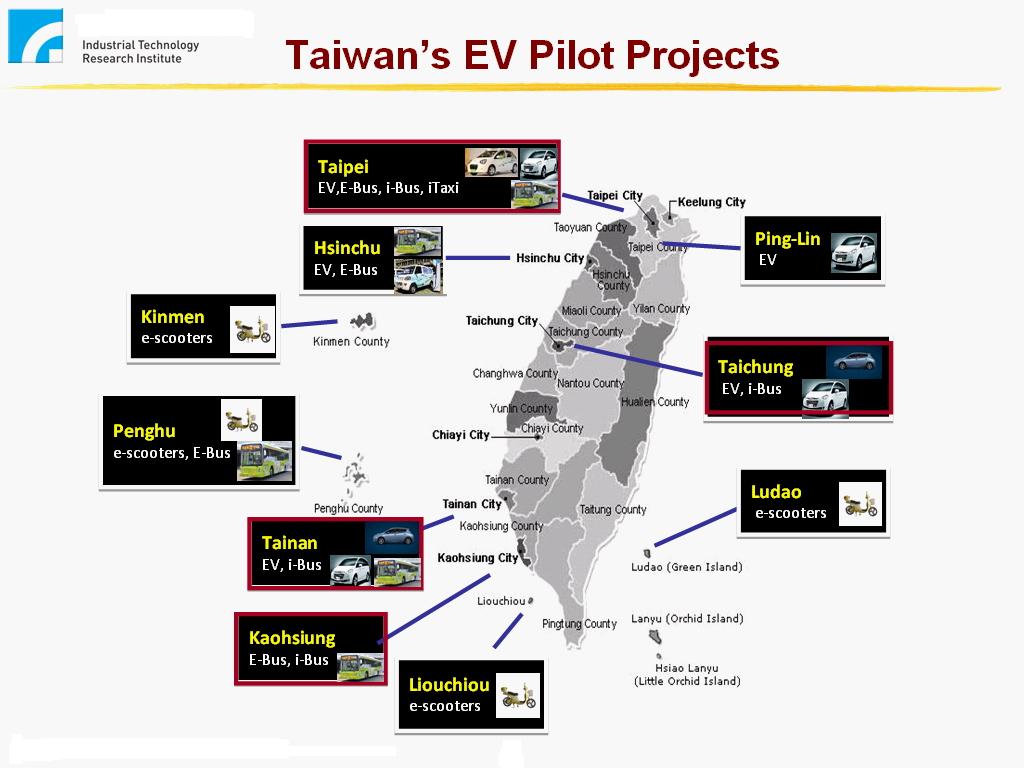V2G Technology Brightens Future for EVs, but Challenges Lie Ahead
Emerging tech will turn cars into power sellers and help even out power grid demand
2014/02/25 | By Quincy LiangBy QUINCY LIANG
The prospects for electric vehicles (EVs) has brightened with the advent of vehicle to grid (V2G) technology, which is expected to cut the operation cost of EVs and improve power utilization. These attractions have prompted several nations to make V2G a focal-point technology in their smart grid development plans.
V2G is a system in which plug-in EVs (PEVs), including plug-in hybrid electric vehicles (PHEVs) and battery electric vehicles (BEVs) can sell surplus electricity to the power grid or throttle electricity use to optimize rates. Since most vehicles are parked 95% of the time, on average, their batteries could be used as storage for electricity from the car to the power lines and back.
Y. C. Huang, a senior analyst of the Industrial Economics & Knowledge Center (IEK) under Taiwan's Industrial Technology Research Institute, says that EV and smart grids are two important and inter-related fields on the road to a low-carbon future. Findings of many pilot projects in different nations have indicated that the V2G technology development will have a major impact on the EV market and create huge business opportunities, though commercial operations are still far away.
The International Energy Agency (IEA) forecast in 2009 that large-scale introduction of PEVs will increase global electricity demand by 10% in 2050. The Electric Power Research Institute (EPRI) also pointed out that when EV penetration in the U.S. reaches 60%, the electric power demand there will increase by 9%. All signs show that increasing PEV penetration will put a heavier burden on the power grid at the generation, delivery and distribution levels, meaning higher costs for power companies.
Power companies, EV makers and information technology (IT) companies have been aggressively trying to map out solutions for charging-time management, with an aim to simultaneously solve problems on both the demand and supply ends. The IEA also forecasted that the on-peak electricity demand in 2050, after the continued introduction of PEVs, would increase by 29% from 2010 in North America. However, G2V management is expected to cut the demand growth to 19%, or potentially to just 12% through better power management.
Over 250,000 V2G Enabled EVs to be Sold by 2022: Navigant Research
Though small today, the market for PEVs equipped with V2G technologies is expected to expand steadily in the coming years.
A recent report from Navigant Research forecasted that compelling business models for V2G technologies are starting to emerge in select markets around the world. The market watcher expects that individually owned EVs would be able to participate in grid services in the second half of this decade. More than 250,000 V2G-enabled PEVs will be sold worldwide from 2013 to 2022, the company forecasts.
"Plug-in electric vehicles can provide services to the grid by changing the rate at which they consume power, thereby reducing peak loads, or by providing power back to the grid, helping to balance loads on the grid," says Scott Shepard, research analyst with Navigant Research. "The benefits to operators also include smoothing the integration of renewable energy resources and generation revenue from ancillary services markets."
The U.S. Department of Defense has been a significant proponent of V2G technology. In early 2013, it announced that it would spend US$20 million to install 500 V2G-enabled PEVs in military bases in specific U.S. electricity markets by the end of the year. Additionally, demonstration and pilot projects using fleet vehicles in the United States, various Western European countries and Japan indicate that V2G technologies can serve as effective assets in various grid services, Navigant Research's report finds.
V2G Benefits
The IEK says that V2G technology has at least three benefits that make it a triple-win for EV users, power companies, and EV makers.
EV users will benefit from the technology by the ability to sell power back to the grid. V2G will help power companies by reducing the need for investment in capacity expansion to meet the need of EV demand. EV-supplied power can also upgrade power-grid efficiency and reliability and expand the scale of regenerated power used the grid.
For EV makers, the V2G will expand the application of their products from transportation to power storage systems, as well as reduce the overall operating cost of EVs, making them more attractive to consumers.
Attractive Market, But . . .
With its high potential to solve different challenges in the EV and energy industries, V2G is generally deemed to have a promising future. However, the IEK says that PEV penetration needs to reach a certain threshold and EV-charging infrastructure needs to be more accessible to make V2G commercialization a reality.

Many nations and regions have made EV charging infrastructure a key component in their smart grid projects, including the U.S., Europe, Japan, South Korea and China. The IEK forecasts that by 2015 the deployment of EV charging infrastructure in industrially advanced nations will increase sharply, driving adoption of BEVs and PHEVs.
Other factors required for the successful commercialization of V2G technology include more mature technology and markets for electric vehicle supply equipment (EVSE), EV batteries, and smart grids. The IEK says that there is still a long way ahead.
Technologies related to battery life, recharging cycles, safety and the most important, cost, are the major issues to be solved before V2G can be more effectively advanced. Additional functions, like rapid charging/discharging, state of charging (SOC) etc., will add costs to V2G-enabled EVs and lead to lower market acceptance. Battery cost, which accounts for approximately 50% of an EV's sticker price, also needs to fall to smooth V2G deployment.

The IKE also notes that related standards and practical business models have to be mapped out for commercialization of V2G systems. For example, EV makers, battery suppliers and power companies all need to jointly work out a set of charging and communication standards.
The knowledge center quotes the example of the successful business model achieved by Apple's iPod portable device and the iTunes music download service, saying that a successful V2G business model should make EV ownership more convenient and also add value to EVs to win over users, makers and power companies.
Taiwan's V2G technology development is currently in the planning stage.




